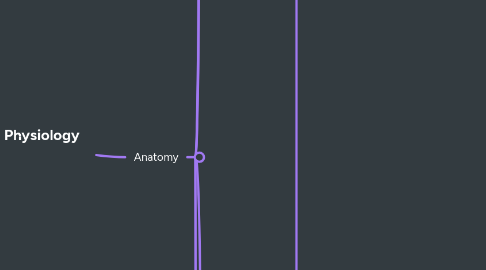
1. Physiology
2. Anatomy
2.1. Basics & Terminology
2.1.1. Medical Affixes
2.1.1.1. Prefixes
2.1.1.1.1. Abdomin/o - Abdomen
2.1.1.1.2. Acr/o - Extremities
2.1.1.1.3. Aden/o - Gland
2.1.1.1.4. Angi/o - Vessel
2.1.1.1.5. Arthr/o - Joint
2.1.1.1.6. Cardi/o - Heart
2.1.1.1.7. Chondr/o - Cartilage
2.1.1.1.8. Cyst/o - Bladder/Sac
2.1.1.1.9. Cyt/o - Cell
2.1.1.1.10. Dent/o - Teeth
2.1.1.1.11. Dermato/o - Skin
2.1.1.1.12. Duden/o - Duodenum
2.1.1.1.13. Gastr/o - Stomach
2.1.1.1.14. Hepat/o - Liver
2.1.1.1.15. Layn/go - Larynx
2.1.1.1.16. My/o - Muscle
2.1.1.1.17. Nephr/o - Kidney
2.1.1.1.18. Neur/o - Nerve
2.1.1.1.19. Oste/o - Bone
2.1.1.1.20. Ot/o - Ear
2.1.1.1.21. Path/o - Disease
2.1.1.1.22. Pneumon/o - Lung
2.1.1.1.23. Rhin/o - Nose
2.1.1.1.24. Stomat/o - Mouth
2.1.1.1.25. Thorac/o - Thorax/Chest
2.1.2. Anatomical Positions
2.1.2.1. Anatomical Planes
2.1.2.1.1. Sagittal Plane
2.1.2.1.2. Medial Plane (Mid-Sagittal Plane)
2.1.2.1.3. Coronal Plane (Frontal)
2.1.2.1.4. Transverse Plane
2.1.2.2. Anatomical Reference Terms
2.1.2.2.1. Up/Down
2.1.2.2.2. Front/Back
2.1.2.2.3. Middle/Outer
2.1.2.2.4. Closer/Farther
2.1.2.2.5. Shallow/Deep
2.1.2.2.6. Surrounding/Internal
2.1.2.2.7. Sided (Right/Left)
2.1.2.3. Body Position Terms
2.1.2.3.1. Supine (Dorsal Recumbent)
2.1.2.3.2. Prone
2.1.2.3.3. Lateral (Side-lying)
2.1.2.3.4. SIMS (Semi-prone)
2.1.2.3.5. Fetal (Knee-Chest)
2.1.2.3.6. Fowler's (Semi-Sitting)
2.1.2.3.7. Orthopneic (Tripod)
2.1.2.3.8. Lithotomy
2.1.2.3.9. Trendelenburg's
2.1.2.3.10. Reverse Trendelenburg's
2.1.2.3.11. Jackknife (Kraske)
2.1.2.3.12. Kidney Position
2.1.2.4. Body Cavities
2.1.2.4.1. Dorsal Body Cavity
2.1.2.4.2. Ventral Body Cavity
2.2. Anatomical Imaging
2.2.1. X-Rays
2.2.1.1. Simple X-Ray
2.2.1.2. Fluoroscopy
2.2.1.3. CT/CAT Scan
2.2.1.4. Mammography
2.2.1.5. Angiography
2.2.2. Sound
2.2.2.1. Ultrasound
2.2.2.2. Echocardiogram
2.2.3. Magnetic Field
2.2.3.1. MRI
2.2.4. Nuclear Medicine
2.2.4.1. PET Scan
2.3. Cytology (Cells)
2.3.1. Basics
2.3.1.1. Cell Theory
2.3.1.2. Size Limitations
2.3.2. Cell Types
2.3.2.1. Prokaryotes
2.3.2.2. Eukaryotes
2.3.3. Intracellular
2.3.3.1. Cell Components
2.3.3.1.1. DNA
2.3.3.1.2. Cell Membrane
2.3.3.1.3. Organelles
2.3.3.1.4. Protoplasm
2.3.4. Extracellular
2.3.4.1. Extracellular Matrix
2.3.4.1.1. Proteins
2.3.5. Fertilization
2.3.6. Defects/Pathology
2.4. Osteology
2.4.1. Basics
2.4.1.1. Functions of the Skeletal System
2.4.1.1.1. Support
2.4.1.1.2. Protection
2.4.1.1.3. Metabolic
2.4.1.1.4. Movement
2.4.1.1.5. Hematopoiesis (Productions of Blood Cells)
2.4.1.2. Features of Bones
2.4.1.2.1. Articular Surfaces
2.4.1.2.2. Bony Elevations
2.4.1.2.3. Bony Depressions
2.4.1.2.4. Perforations
2.4.1.3. Composition of Bones
2.4.1.3.1. Matrix
2.4.1.3.2. Minerals
2.4.1.4. Components of Bones
2.4.1.4.1. Cells
2.4.1.4.2. Epiphysis
2.4.1.4.3. Diaphysis
2.4.1.4.4. Metaphysis
2.4.1.4.5. Epiphysial Plate
2.4.1.4.6. Periosteum
2.4.2. Components of the Skeletal System
2.4.2.1. Bones (206)
2.4.2.1.1. By Position
2.4.2.1.2. By Structure
2.4.2.1.3. By Development
2.4.2.1.4. By Shape
2.4.2.2. Cartilage
2.4.2.2.1. Hyaline Cartilage
2.4.2.2.2. Fibrocartilage
2.4.2.2.3. Yellow Elastic Cartilage
2.4.2.3. Ligaments
2.4.2.4. Joints
2.4.2.4.1. Fibrous Joints
2.4.2.4.2. (Fibro)Cartilaginous Joints
2.4.2.4.3. Synovial Joints (Diarthrotic)
2.4.2.4.4. By Movement
2.4.3. Skeletal Pathology
2.4.3.1. Congenital
2.4.3.1.1. Syndactyly
2.4.3.1.2. Achondroplastic Drawfism
2.4.3.1.3. Cleft Lip
2.4.3.1.4. Cleft Palate
2.4.3.1.5. Polydactyly
2.4.3.1.6. Phocomelia
2.4.3.1.7. Spinal (Spina) Bifida
2.4.3.1.8. Club Foot
2.4.3.1.9. Congenital Hip Dislocation
2.4.3.2. Inflammatory
2.4.3.2.1. Osteomyelitis
2.4.3.3. Metabolic and Endocrine
2.4.3.3.1. Ricketts
2.4.3.3.2. Osteoporosis
2.4.3.3.3. Acromegaly
2.4.3.4. Fractures
2.4.3.4.1. Break in bone tissue
2.4.3.5. Tumors of Bones
2.4.3.5.1. Osteomas
2.4.3.5.2. Osteosarcomas
2.5. Embryology
2.5.1. Embryo
2.5.1.1. Trilaminar Embryo
2.5.1.1.1. Ectoderm
2.5.1.1.2. Mesoderm
2.5.1.1.3. Endoderm
2.6. Neurology
2.6.1. Nervous System
2.6.1.1. Cranial Nerves
2.6.1.1.1. CNI - Olfactory Nerve
2.6.1.1.2. CNII - Optic Nerve
2.6.1.1.3. CNIII - Oculomotor Nerve
2.6.1.1.4. CNIV - Trochlear Nerve
2.6.1.1.5. CNV - Trigeminal Nerve
2.6.1.1.6. CNVI - Abducens Nerve
2.6.1.1.7. CNVII - Facial Nerve
2.6.1.1.8. CNVIII - Vestibulocochlear Nerve
2.6.1.1.9. CNIX - Glossopharyngeal Nerve
2.6.1.1.10. CNX - Vagus Nerve
2.6.1.1.11. CNXI - Spinal Accessory Nerve
2.6.1.1.12. CNXII - Hypoglossal Nerve
